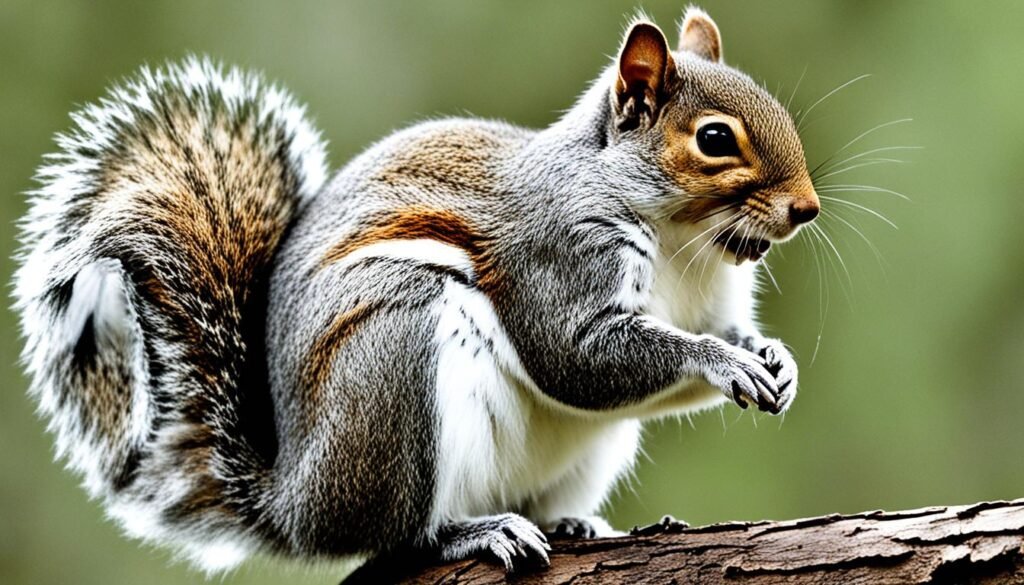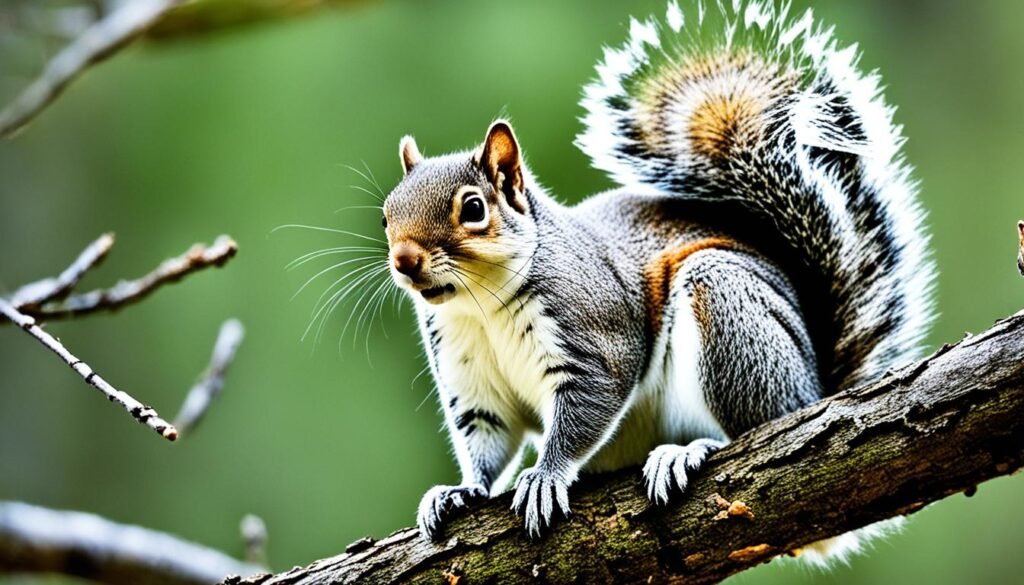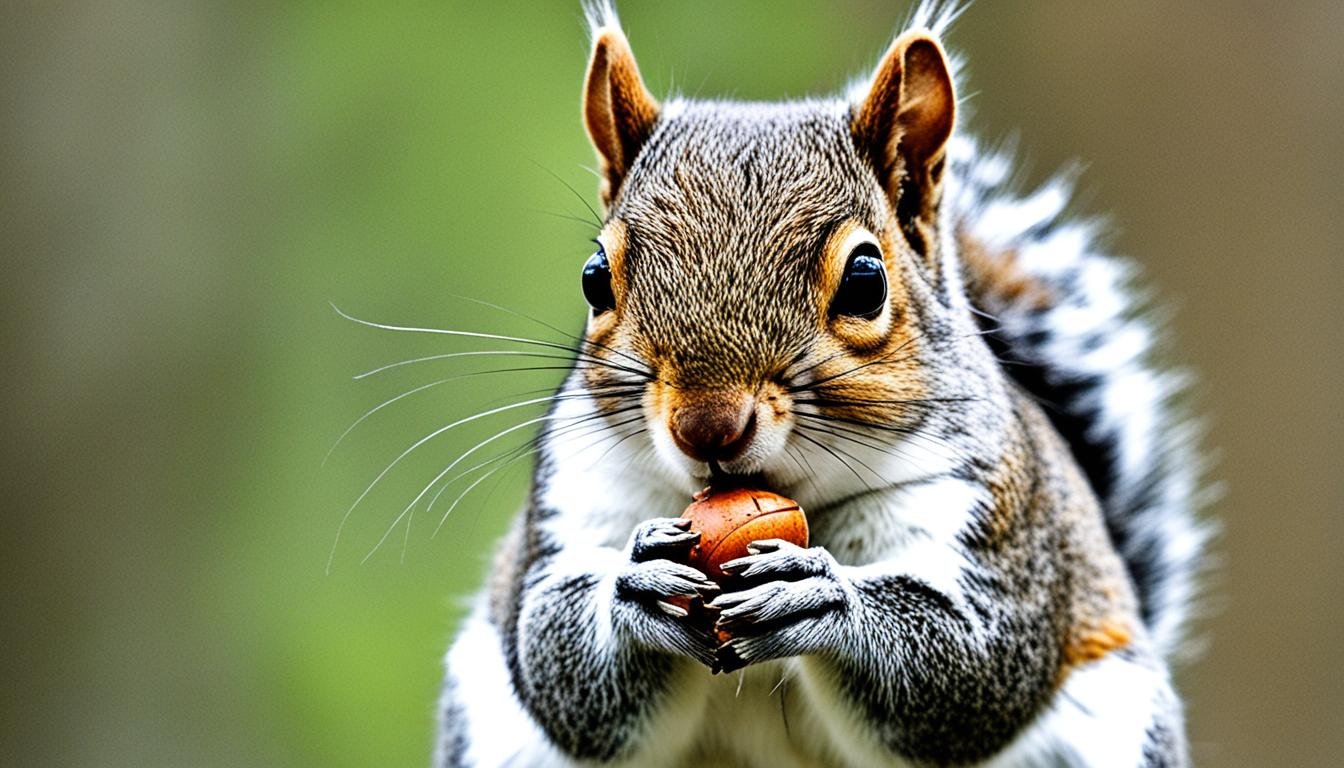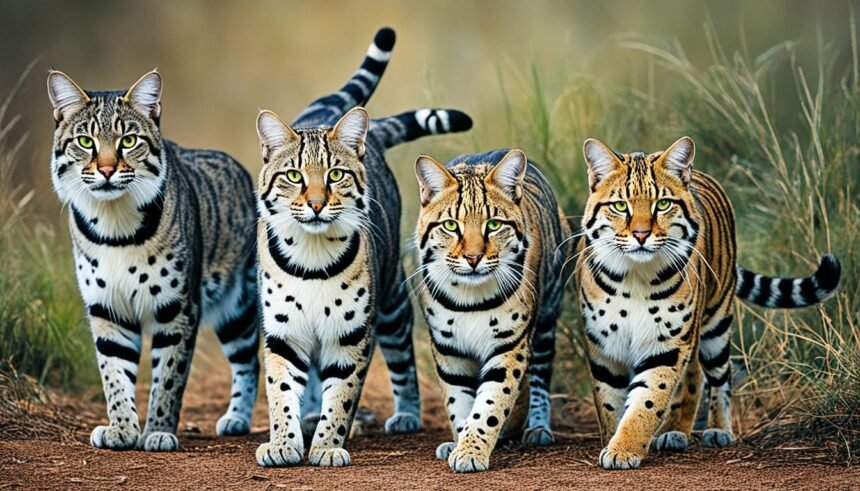The eastern gray squirrel (Sciurus carolinensis), also known as the grey squirrel, is a tree squirrel from eastern North America. It’s the most common and important forest regenerator in its home area. Introduced to some parts of the world, it’s seen as an invasive species in Europe. Here, it has taken over the native Eurasian red squirrel’s (Sciurus vulgaris) territory in many places.
This squirrel has mostly gray fur and a white belly, with a big, bushy tail. It’s a medium-sized tree squirrel with no size or color difference between males and females. Some populations also have melanistic and leucistic forms.
This squirrel is a scatter-hoarder, making many caches of nuts, seeds, and other food for later. It uses clever caching behaviors to keep its food safe from other animals.
Introduction to the Eastern Gray Squirrel
Native Range and Habitat
The eastern gray squirrel (Sciurus carolinensis) calls the eastern and midwestern United States home. It also lives in the southern parts of Canada’s central provinces. These tree squirrels love mature, continuous woodlands that cover over 40 hectares. They prefer forests with trees like oaks and walnuts, which provide food for winter.
Physical Characteristics and Identification
This medium-sized tree squirrel measures 23 to 30 cm (9.1 to 11.8 inches) in length and has a tail of 19 to 25 cm (7.5 to 9.8 inches). It weighs between 338 to 750 grams (11.91 to 26.43 ounces). You can find them in various colors, from gray to brown, black, and even white.
Their bushy tails and big, bright eyes make them stand out. These features help identify them in the wild.
Sciurus Carolinensis: Binomial Nomenclature

The eastern gray squirrel is known by its scientific name Sciurus carolinensis. It’s part of the Sciuridae family, which has about 230 squirrel species worldwide. The name Sciurus comes from Greek, meaning “shadow” and “tail,” because of its tail habit.
The name “carolinensis” means it was first found in the Carolinas, USA. This squirrel is a key rodent in North America, known for its wide spread and popularity.
- There are 2,280 species of rodents grouped into 34 families, with about 40% of all known mammal species being rodents.
- The Sciuridae family consists of 51 extant genera and around 230 species.
- The Sciurus genus encompasses 30 species in eight subgenera.
The Sciurus genus includes many species, but the eastern gray squirrel (Sciurus carolinensis) is especially well-studied. It has a long history in taxonomy, ecology, and conservation biology.
Behavior and Ecology of Gray Squirrels
The eastern gray squirrel (Sciurus carolinensis) is known for its amazing foraging and food caching behaviors. It buries thousands of caches of nuts, seeds, and other food items throughout the year. These squirrels have great spatial memory, using landmarks to find their hidden caches. Their sense of smell helps them find their own caches and those of others.
Foraging and Food Caching Habits
Eastern gray squirrels are flexible foragers, fitting into different habitats. They are common in urban parks, forests, and neighborhoods but rare in cemeteries and golf courses. Their numbers go up with more people, roads, and less tree cover, showing they can live in changed environments.
Deceptive Behaviors and Intelligence
These squirrels use complex behaviors, like tricks to keep their food safe. They might pretend to bury a nut, then take it back and hide it elsewhere to keep others from finding it. Their memory and problem-solving skills are impressive, helping them protect their food.
| Behavior | Observation |
|---|---|
| Flight Initiation Distance (FID) | Squirrels in urban park, forest, and neighborhood habitats had the least FID, indicating lower risk perception, while those in cemeteries and golf courses had the greatest FID. |
| Escape Response | Across different urban habitats, most eastern gray squirrels displayed a common escape response, fleeing by sprinting a short distance and then stopping. |
| Boldness and Neophobia | Behavioral shifts in urban eastern gray squirrels include increased boldness, decreased neophobia (fear of new things), and decreased fear of humans. |
Reproduction and Life Cycle
The eastern gray squirrel, Sciurus carolinensis, breeds twice a year. In the south, mating happens from December to February. In the north, it’s from May to June. During these times, females may mate with several males, leading to fierce competition among them.
Breeding Seasons and Gestation
Gestation lasts about 44 days for these squirrels. Females can have litters of 1 to 9 young, with an average of 2 to 3. The newborns are altricial, needing care and food from their parents.
Development and Maturity
The young open their eyes at 24-42 days old and their ears by 3-4 weeks. They start weaning at 56-70 days and grow their adult fur. Males reach sexual maturity at about 10-11 months old, but not all young ones breed right away.
The average life span for an adult is 6 years. The longest recorded life was 12 years in the wild and 20 years in captivity.
Diseases and Parasites in Gray Squirrels
The eastern gray squirrel, Sciurus carolinensis, faces many diseases and parasites. These can harm its health and survival. They can carry and spread illnesses like typhus, plague, and tularemia. If not treated, these diseases can be deadly. Humans can get these diseases from the squirrel’s bites or fluids.
Eastern gray squirrels also host parasites like ringworm, fleas, lice, mites, and ticks. These can cause skin issues and hair loss, especially in winter. Ticks from these squirrels can spread Lyme disease and Rocky Mountain spotted fever. These diseases can harm the squirrel’s organs if not treated.
Other diseases affect eastern gray squirrels too. Fibromatosis causes tumors, and squirrelpox is a deadly poxvirus. These outbreaks show why it’s key to understand and manage diseases and parasites in these urban animals.
| Disease/Parasite | Transmission | Potential Impacts |
|---|---|---|
| Typhus, Plague, Tularemia | Spread through bodily fluids, bites | Potentially fatal if untreated |
| Ringworm, Fleas, Lice, Mites, Ticks | Direct contact, vector-borne | Skin problems, hair loss |
| Lyme Disease, Rocky Mountain Spotted Fever | Tick-borne | Organ damage if untreated |
| Fibromatosis, Squirrelpox | Viral transmission | Tumors, mortality |
Knowing about the diseases and parasites affecting eastern gray squirrels is key. It helps in their conservation and protects human health where they live.
Communication and Sensory Perception

The eastern gray squirrel, Sciurus carolinensis, is very talkative and perceptive. It uses many ways to understand its world. These small rodents use sounds, body language, and tail movements to talk to each other.
They make different sounds like barks and chatters to warn others or talk socially. They also use body language and tail movements to show what they feel or want.
These squirrels have a strong sense of smell. They use it to know about the stress and reproductive state of others. This helps them in social interactions and finding mates. They use smell, sight, touch, and sound to understand and talk to their world.
| Sensory Modality | Significance in Eastern Gray Squirrel Communication |
|---|---|
| Vocalizations | Warn of threats, signal alarm, and facilitate social interactions |
| Postures and Tail Flicking | Convey intentions and emotional states to conspecifics |
| Olfaction | Assess stress levels and reproductive condition of neighbors |
Using many senses helps eastern gray squirrels live well in different places. They can talk to each other and handle their social and natural worlds.
Predators and Defense Mechanisms
The eastern gray squirrel, known as Sciurus carolinensis, faces many predators that threaten its survival. These include American mink, weasels, red foxes, bobcats, gray wolves, coyotes, lynx, and birds of prey like red-tailed hawks. To protect themselves, eastern gray squirrels have developed smart defense strategies.
Natural Predators and Threats
These squirrels use their agility and speed to defend against predators. They move quickly through trees, climb trunks, and jump between branches. Their small size and fast moves make them hard to catch. They also warn other squirrels with calls when they spot a predator, helping them escape.
Even with these defenses, eastern gray squirrels face threats from predators. Birds like red-tailed hawks can attack from above. Ground predators like weasels and foxes can ambush them. Wolves and coyotes are a big risk, especially when they’re far from tree cover.
To avoid predators, eastern gray squirrels have learned to adapt. They hide their food in different spots, making it hard for predators to find. They also use their sharp senses to spot dangers and get away quickly.
Ecosystem Roles and Impacts

The eastern gray squirrel, Sciurus carolinensis, is key to its ecosystems. It eats a lot of nuts, seeds, and other tree products. This helps spread tree seeds, which helps forests grow and become more diverse.
They also help spread truffle spores when they eat these fungi. This is good for the fungi and the trees that depend on them.
Eastern gray squirrels are important to the food web too. Many animals, like hawks and owls, eat them. On the other hand, they carry ticks and fleas that affect other animals in the ecosystem.
Seed Dispersal and Fungal Spore Distribution
These squirrels bury nuts and seeds for later. Sometimes, these seeds grow into new trees, helping forests to heal and grow. They also spread truffle spores when they eat these fungi, which helps the fungi grow.
| Ecosystem Impact | Description |
|---|---|
| Seed Dispersal | Eastern gray squirrels bury and cache nuts and seeds, leading to the germination and establishment of new trees, promoting forest regeneration and diversity. |
| Fungal Spore Distribution | Foraging on truffles, eastern gray squirrels inadvertently distribute the spores of these mycorrhizal fungi, supporting their growth and proliferation. |
| Prey and Parasite Hosts | As prey animals, eastern gray squirrels provide sustenance for predators, while also hosting a range of parasites that can impact other species in the ecosystem. |
The eastern gray squirrel has a big effect on forests. They help spread seeds and fungi spores, and they are part of the food web. This makes them very important to the ecosystem.
Invasive Species Status and Management
The eastern gray squirrel (Sciurus carolinensis) is an invasive species in Europe. It was introduced from North America and has spread widely. Now, it lives in Ireland, Britain, and Italy, pushing the native Eurasian red squirrel (Sciurus vulgaris) out of its home.
Research on managing gray squirrels has been ongoing since 1997. Studies show that in Italy, the gray squirrel has taken over some areas where the red squirrel used to live. In the UK, diseases like the squirrelpox virus have led to fewer red squirrels over time.
| Invasive Species Impact | Management Strategies |
|---|---|
|
|
To fight the threat of the eastern gray squirrel, many strategies have been put in place. These aim to protect the native Eurasian red squirrel. They include controlling the squirrel population through trapping and culling, managing habitats for red squirrels, and researching how to stop the invasion. Also, campaigns are spreading awareness to get people to report gray squirrel sightings, helping to track and control their numbers.
Conclusion
The eastern gray squirrel, known as Sciurus carolinensis, is a common and studied tree squirrel from eastern North America. It plays a key role in its ecosystems. It helps spread seeds, fungal spores, and is food for many predators.
But, when brought to Europe, it became an invasive species. It can outcompete and replace native squirrels like the Eurasian red squirrel. This has caused big problems for the local ecosystems and conservation efforts.
We need to work on controlling the eastern gray squirrel to protect our native ecosystems. By learning about its biology and effects, we can make better plans to manage it. This will help keep our natural environments healthy for the future.
FAQ
What is the scientific name of the eastern gray squirrel?
The eastern gray squirrel is known as Sciurus carolinensis.
Where is the eastern gray squirrel native to?
It’s found in the eastern and midwestern U.S. and southern parts of Canada’s central provinces.
What are the physical characteristics of the eastern gray squirrel?
It has gray fur, a white belly, and a big, bushy tail. It’s a medium-sized tree squirrel. There’s no difference in size or color between males and females. Some have melanistic or leucistic traits.
How does the eastern gray squirrel communicate and perceive its environment?
They talk to each other with sounds and body language, like tail flicks. They also use their sense of smell to learn about others, like stress levels and if they’re ready to mate.
What are the natural predators of the eastern gray squirrel?
Predators include American mink, weasels, red foxes, bobcats, gray wolves, coyotes, lynx, and birds like red-tailed hawks. They warn each other with calls to stay safe.
What is the status of the eastern gray squirrel as an invasive species?
In Europe and other places outside North America, it’s seen as an invasive species. It has taken over areas like Ireland, Britain, and Italy, pushing out the native Eurasian red squirrel.
What is the eastern gray squirrel’s role in its ecosystem?
They eat a lot of nuts and seeds, helping to spread tree seeds. They also help spread truffle spores when they eat truffles. As prey, they support the food web in forests.













